Deep History Of America’s Deep State (1)
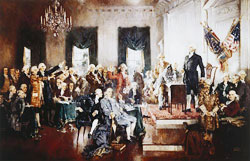 Everybody seems to be talking about the Deep State these days. Although the term appears to have entered the lexicon in the late 1990s, for years it referred only to shady foreign governments, certainly not to the U.S. “indispensable nation”.
Everybody seems to be talking about the Deep State these days. Although the term appears to have entered the lexicon in the late 1990s, for years it referred only to shady foreign governments, certainly not to the U.S. “indispensable nation”.
Does the sudden presence of an American Deep State – loosely defined as an unelected elite that manipulates the elected government to serve its own interests – pose a novel, even existential, threat to democracy?
The threat seems real enough, but it’s nothing new. Consider these facts: 230 years ago, an unelected group of elite Americans held a secretive meeting with an undisclosed agenda. Their purpose was not merely to manipulate lawful government in their own interests, but to abolish it altogether. In its place, they would install a radically undemocratic government – a “more perfect” government, they said – better suited to their investment portfolios.
History does not identify these conspirators as the Deep State. It calls them the Founders. The Founders did not consider themselves conspirators, but “republicans” – not in reference to any political party, but rather to their economic station in society.
But their devotion to “republicanism” was transparently self-serving. A current college text, The American Journey: A History of the United States, explains, though does not explicate “republican ideology”: “Their main bulwark against tyranny was civil liberty, or maintaining the right of the people to participate in government. The people who did so, however, had to demonstrate virtue. To eighteenth century republicans, virtuous citizens were those who were focused not on their private interests but rather on what was good for the public as a whole.
They were necessarily property holders, since only those individuals could exercise an independence of judgment impossible for those dependent upon employers, landlords, masters, or (in the case of women and children) husbands and fathers.”
Republicanism was a handy idea if you happened to be a master or a landlord, who were the only persons this ideology considered “virtuous” enough to vote or hold political office. Thus, “republicanism” – virtually indistinguishable from today’s “neoliberalism” – created the original Deep State in the image of the economic system it was designed to perpetuate. How this was accomplished is not a comforting tale. But it cannot be related nor understood without an appreciation of the historical context in which it occurred.
Masters and Servants
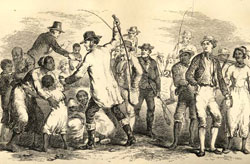 Post-colonial America was predominantly agrarian, and about 90 percent of the population were farmers. (The largest city in 1790 was New York, with a whopping population of 33,000 residents.) There was a small middle class of artisans, shopkeepers, and even a handful of industrial workers, but the politically and economically powerful people were the relatively few big-time merchants and landowners – who also fulfilled the function of bankers.
Post-colonial America was predominantly agrarian, and about 90 percent of the population were farmers. (The largest city in 1790 was New York, with a whopping population of 33,000 residents.) There was a small middle class of artisans, shopkeepers, and even a handful of industrial workers, but the politically and economically powerful people were the relatively few big-time merchants and landowners – who also fulfilled the function of bankers.
America was not quite a feudal society, but it resembled one. Commoners did not call at the front doors of the rich, but were received around back. Most states had official religions, some with compulsory church attendance backed by fines. Commodity-barter was the currency of the day for the vast majority.
Debtors were imprisoned. Parents sold their children into bondage. It wasn’t what most people think of when they hear “Yankee Doodle Dandy”.
All states restricted voting only to men who owned a requisite amount of property, while the majority: un-widowed women, servants, and tenants owned no property. Moreover, most states had property requirements for eligibility to elective office, some with the higher offices reserved for those with the most property. Such restrictions had discriminated against the urban underclass and farmers since the beginning of American colonization.
Nobody at the time characterized this land of masters and servants as a “democracy”. Indeed, the master class considered “democracy” synonymous with “mob rule”. But not everybody was happy with “republican virtue” in post-war America, least of all the slaves of the “virtuous”.
The Revolutionary War had stirred passions among the servant class for social and economic liberty, but when the war ended nothing much had changed.
In fact, the war proved not to have been a revolution at all, but represented only a change from British overlords to American overlords. Edmund Morgan, considered the dean of American history in the colonial era, characterized the “non-Revolutionary War” this way: “The fact the lower ranks were involved in the contest should not obscure the fact that the contest itself was generally a struggle for office and power between members of an upper class: the new against the established.”
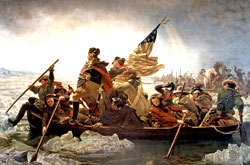 About 1 percent of the American population had died in a war fought, they had been told, for “liberty”. (Compare: if the U.S. lost the same proportion of its population in a war today, the result would be over three million dead Americans!) Yet after the war, economic liberty was nowhere in sight.
About 1 percent of the American population had died in a war fought, they had been told, for “liberty”. (Compare: if the U.S. lost the same proportion of its population in a war today, the result would be over three million dead Americans!) Yet after the war, economic liberty was nowhere in sight.
Moreover, the very concept of “liberty” meant one thing to a farmer and quite another to his rich landlord or merchant. Liberty for a common farmer – who was generally a subsistence farmer who did not farm to make money, but rather only to provide the necessities of life for his family – meant staying out of debt.
Liberty for merchants and property owners – whose business was to make monetary profits – meant retaining the ability to lend or rent to others and access to the power of government to enforce monetary repayment from debtors and tenants.
Much like the American Indians who had first communally owned the property now occupied by American subsistence farmers, agrarian debtors faced the unthinkable prospect of losing their ability to provide for their families (and their vote) if their land were confiscated for overdue taxes or debt.
Loss of their land would doom a freeholder to a life of tenancy. And the servitude of tenants and slaves differed mainly as a function of iron and paper: slaves were shackled by iron, tenants were shackled by debt contracts. But iron and paper were both backed by law.
By the end of the Revolutionary War, as few as a third of American farmers owned their own land. When the urban elites began to foreclose on the debts and raise the taxes of subsistence farmers – many of whom had fought a long and excruciating war to secure their “liberty” – it amounted to a direct assault on the last bastion of Americans’ economic independence.
The Original Great Recession
After the war, British merchants and banks no longer extended credit to Americans. Moreover, Britain refused to allow Americans to trade with its West Indies possessions. And, to make matters worse, the British Navy no longer protected American ships from North African pirates, effectively closing off Mediterranean commerce.
Meanwhile, the American navy could not protect American shipping, in the Mediterranean or elsewhere, because America did not happen to possess a navy.
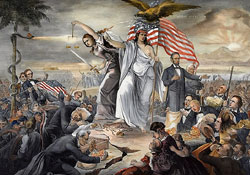 In the past, American merchants had obtained trade goods from British suppliers by “putting it on a tab” and paying for the goods later, after they had been sold. Too many Americans had reneged on those tabs after the Revolution, and the British now demanded “cash on the barrelhead” in the form of gold and silver coin before they would ship their goods to America.
In the past, American merchants had obtained trade goods from British suppliers by “putting it on a tab” and paying for the goods later, after they had been sold. Too many Americans had reneged on those tabs after the Revolution, and the British now demanded “cash on the barrelhead” in the form of gold and silver coin before they would ship their goods to America.
As always, Americans had limited coin with which to make purchases. As the credit crunch cascaded downwards, wholesalers demanded cash payment from retailers, retailers demanded cash from customers. Merchants “called in” loans they had made to farmers, payable in coin.
Farmers without coin were forced to sell off their hard-earned possessions, livestock, or land to raise the money, or risk court-enforced debt collection, which included not only the seizure and sale of their property but also imprisonment for debt.
The most prominent result of Americans’ war for “liberty” turned out to be a full-blown economic recession that lasted a decade. Even so, the recession would not have posed a life-threatening problem for land-owning subsistence farmers, who lived in materially self-sufficient, rural, communal societies.
But when state governments began to raise taxes on farmers, payable only in unavailable gold and silver coin, even “self-sufficient” farmers found themselves at risk of losing their ability to feed their families.
Debt, Speculation, and the Deep State
The Continental Congress had attempted to pay for its war with Britain by printing paper money. The British undermined these so-called “Continental” dollars, not only by enticing American merchants with gold and silver, but by counterfeiting untold millions of Continental dollars and spending them into circulation.
The aggregate result was the catastrophic devaluation of the Continental dollar, which by war’s end was worthless. In the meantime, both Congress and state governments had borrowed to pay for “liberty”. By war’s end, war debt stood at $73 million, $60 million of which was owed to domestic creditors. It was a staggering sum of money.
In his now studiously ignored masterpiece, An Economic Interpretation of the Constitution of the United States, historian Charles A. Beard showed that domestically-held war debt was equivalent to 10 percent of the value of all the surveyed land holdings (including houses) in the entire United States at the time.
The war debt carried interest, of course – which is a problem with debt if you owe it, but is a feature of debt if it is owed to you. Not only was “freedom” not “free” – it came with dividends attached for Deep State investors. This should sound at least vaguely familiar today.
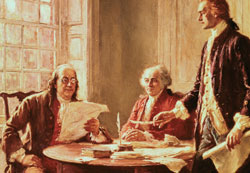 As Continental paper money lost its value, Congress and state governments continued to pay for “liberty” with coin borrowed at interest. When that ran short, government paid only with promises to pay at a later date – merely pieces of paper that promised to pay coin (or land) at some indeterminate time after the war was won.
As Continental paper money lost its value, Congress and state governments continued to pay for “liberty” with coin borrowed at interest. When that ran short, government paid only with promises to pay at a later date – merely pieces of paper that promised to pay coin (or land) at some indeterminate time after the war was won.
This was how the government supplied the troops (whenever it managed to do so) and also how it paid its troops. In actual practice, however, Congress often did not pay the troops anything, not even with paper promises, offering only verbal promises to pay them at the end of the war.
But war is never a money-making enterprise for government, and when it ended, the government was as broke as ever. So, it wrote its verbal promises on pieces of paper, and handed them to its discharged troops with a hearty Good Luck with That! Even so, Congress paid the soldiers in bonds worth only a fraction of the amount of time most had served, promising (again!) to pay the balance later – which it never did.
Thousands of steadfast, longsuffering troops were abandoned this way. Most had not been paid any money in years (if ever), and many were hundreds of miles from their homes – ill, injured, and starving – as they had been for months and years. Others literally were dressed only in rags or pieces of rags.
Some carried paper promises of money; some carried paper promises of geographically distant land – none of which would be available until years in the future, if at all.
Seven-year Revolutionary War veteran Philip Mead described his plight in a bitter memoir entitled A Narrative of Some of the Adventures, Dangers and Sufferings of a Revolutionary Soldier: “We were absolutely, literally starved. I do solemnly declare that I did not put a single morsel of victuals in my mouth for four days and as many nights, except a little black birch bark which I gnawed off a stick of wood, if that can be called victuals. I saw several of the men roast their old shoes and eat them…
When the country had drained the last drop of service it could screw out of the poor soldiers, they were turned adrift like old worn-out horses, and nothing said about land to pasture them on.”
Was this liberty? To impoverished veterans, “liberty” looked bleak, indeed. To speculators in government bonds, liberty looked like a golden opportunity, quite literally so.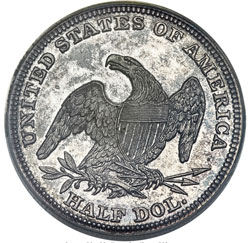 Vultures possessed of coin swooped in and bought a dollar’s worth of government promises for a dime, and sometimes for just a nickel. Speculators wheedled promises not only from desperate veterans (many of whom sold their promises merely to obtain food and clothes on their long trudge home), but from a host of people whose goods or services had been paid with IOUs.
Vultures possessed of coin swooped in and bought a dollar’s worth of government promises for a dime, and sometimes for just a nickel. Speculators wheedled promises not only from desperate veterans (many of whom sold their promises merely to obtain food and clothes on their long trudge home), but from a host of people whose goods or services had been paid with IOUs.
Optimistic speculators cadged bonds from pessimistic speculators. The more desperate people became during the recession, the more cheaply they sold their promises to those who were not.
Speculators expected their investments, even those made with now-worthless paper money, to be paid in gold or silver coin. What’s more, “insiders” expected all those various government promises would eventually be converted – quietly, if possible – into interest-bearing bonds backed by a single, powerful taxing authority.
All the Deep State needed now was a national government to secure the investment scheme. A man named Daniel Shays unwittingly helped to fulfil that need.
Rebellion and Backlash
Thomas Jefferson penned the famous sentence: “The tree of liberty must be refreshed from time to time with the blood of patriots and tyrants.” He was not referring to heroic American Patriots charging up Bunker Hill against British bayonets. He was referring instead to American farmers – many of whom had been the starving soldiers in a war for forsaken liberty – taking their lives into their hands to oppose the tax policies of the government of Massachusetts in 1787.
The principal leader of this revolt was a farmer and war veteran Daniel Shays. In a sense, the most interesting thing about Shays’ Rebellion is that it was not a unique event.
The first notable example of agrarian revolt had been Bacon’s Rebellion in 1676 Virginia, when frontier farmers marched on the rich plantation owners of Jamestown, burned it to the ground, published their democratic Declaration of the People, and threatened to hang every elite “tyrant” on their list – which included some of the forefathers of America’s patriot Founders.
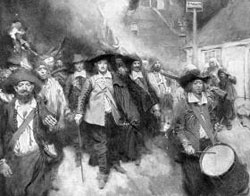 Historian Gary Nash reminds us Bacon’s Rebellion had echoes across early American history: “Outbreaks of disorder punctuated the last quarter of the 17th century, toppling established governments in Massachusetts, New York, Maryland, Virginia, and North Carolina.”
Historian Gary Nash reminds us Bacon’s Rebellion had echoes across early American history: “Outbreaks of disorder punctuated the last quarter of the 17th century, toppling established governments in Massachusetts, New York, Maryland, Virginia, and North Carolina.”
Jimmy Carter, in The Hornet’s Nest, the only novel ever published by an American president, tells a similar story of the agony of dispossessed farmers in Georgia a century later.
Other farmers had rebelled in New Jersey in the 1740s; in the New York Hudson Valley rent wars in the 1750s and 1760s and concurrently in Vermont by Ethan Allen’s Green Mountain Boys; for a decade in North Carolina in the 1760s, where vigilantes called Regulators battled the government of the urban elite; and in Virginia in the 1770s.
Likewise, American cities had been scenes of labor unrest, riots, and strikes for a century. American class rebellion, apparently unbeknownst to most history teachers in America, was closer to the rule than the exception.
Victory in the war against England only intensified the conflict between those who considered “liberty” as a necessary condition to live without debt, against those who considered “liberty” to be their class privilege to grow rich from the debts others owed them.
Howard Zinn, in his A People’s History of the United States describes the economic realities of Eighteenth Century America: “The colonies, it seems, were societies of contending classes – a fact obscured by the emphasis, in traditional histories, on the external struggle against England, the unity of colonists in the Revolution. The country therefore was not ‘born free’ but born slave and free, servant and master, tenant and landlord, poor and rich.”
Although Shays’ Rebellion was not unique, it was a huge event, coming at a time when the rich were owed a great deal of money by impoverished governments. Pressured by rich bondholders and speculators, the government of Massachusetts duly raised taxes on farmers.
To make matters far worse, the taxes were to be paid only in gold or silver – which was completely out of the question for most western farmers, who had no way to obtain coined money.
When the farmers complained, their complaints were ignored. When farmers petitioned the government to issue paper money and accept it as payment of debts and taxes, the government refused their petitions. When the farmers pleaded for the passage of “legal tender laws” that would allow them to settle their debts or taxes with their labor, they were rebuffed.
But when farmers could not pay what they did not have, the Massachusetts’s courts ordered their land seized and auctioned. At last, the farmers understood the practical effect, if not the specific intent, of the tax: confiscation of their property and its transfer to the rich, to whom the government owed its interest-bearing debt. Government had become an armed collection agency.
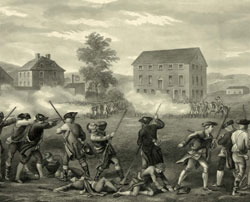 To the utter dismay of the erstwhile proudly tax-rebellious Patriots, the farmers too rebelled. Shays-ites forcibly shut down the tax courts that were condemning them to servitude.
To the utter dismay of the erstwhile proudly tax-rebellious Patriots, the farmers too rebelled. Shays-ites forcibly shut down the tax courts that were condemning them to servitude.
The rich responded by loaning the destitute government more money (at interest!) to pay a militia force to oppose Shays’ rebels.
At this point, tax rebels abandoned reform for radical revolution and – in a resounding echo of Nathaniel Bacon’s century-old Declaration of the People – pledged to march on Boston and burn it to the ground. This was no Tea Party vandalism, stage-managed by well-to-do Bostonians like Samuel Adams. It was a full-blown, grassroots agrarian revolution a century in the making.
The urban bond-holding merchant-class in Boston and elsewhere panicked. And none panicked more than bond speculators, who intimately understood the rebels threatened their “virtuous” republican “liberty” to extract profit from others.
Historian Woody Holton exposes the astonishing callousness of one of America’s major bond speculators in his nationally acclaimed Unruly Americans and the Origin of the Constitution: “As a bondholder, Abigail Adams would benefit immensely if her fellow Massachusetts citizens [paid the tax] levied by the legislature in March 1786, but she also saw compliance as a sacred duty. If Massachusetts taxpayers were ‘harder-prest by publick burdens than formerly,’ she wrote, ‘they should consider it as the price of their freedom’.”
Future First Lady Abigail Adams was not alone in thinking freedom came with dividends payable to her account. Historian David Szatmary reminds us in his Shays Rebellion – The Makings of an Agrarian Insurrection that the former Patriot leadership, especially those in the merchant class, were among the first to advocate violence against democratic rebellion. Said published an opinion piece at the time: “When we had other rulers, committees and conventions of the people were lawful – they were then necessary; but since I myself became a ruler, they cease to be lawful – the people have no right to examine my conduct.”
Read the second part of this article
yogaesoteric
January 26, 2018
